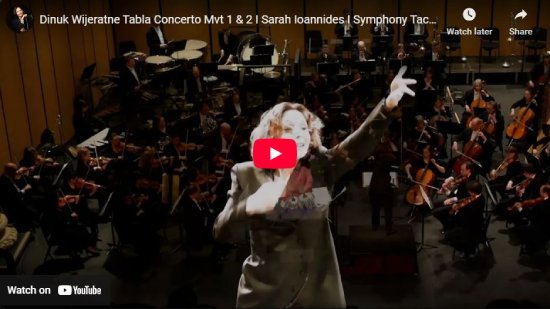It’s not surprising that the music of Dinuk Wijeratne reflects so deeply on identity, especially cultural identity. The award-winning composer, conductor, pianist, and educator was born in Sri Lanka, raised in Dubai, and studied in the U.K., and at Juilliard in New York, before settling in Canada. His work reflects all those influences and more, starting with the South Indian percussion he played as a child.
“I loved those traditions, and the sounds went right into my ear,” he says. “Then I switched to piano, and fell in love with Mozart, and it became a lot of classical music for the next few years. But what I didn’t realize, growing up in the Middle East, was that all of these other influences were going in too, and eventually they had to find a balance.”

Select the image to access the YouTube video of the Identity: a Song Cycle trailer, with music composed by Dinuk Wijeratne
Wijeratne mixed a Western classical orchestra with South Asian percussion in his Tabla Concerto, and a string quartet with DJ Skratch Bastid’s turntables on the JUNO Award-winning Spin Cycle. He and Syrian-born clarinetist Kinan Azmeh riffed on Hungarian composer Bela Bartok in After Bela, and formed a jazz trio with tabla player Mayookh Bhaumik for This Way Up, with Wijeratne playing not just the piano’s keys, but the strings under its lid, making it a melodic, stringed, and percussion instrument in one piece.
His latest work, Identity: A Song Cycle, arose out of an Instagram post written by biracial singer Elliot Madore in the wake of the George Floyd protests. Director Joel Ivany introduced Madore to Wijeratne, who wrote music for voice, piano, bass, and percussion, set to poems by Shauntay Grant. They made a video of the first five songs in 2022, and the full 10-song work premiered May 23 and 24, 2025, at the Marilyn and Charles Baillie Theatre in Toronto. An orchestral version of five of the songs is also in the works, to be performed by the National Arts Centre Orchestra.
“I’d describe it as contemporary art song with global influences,” says Wijeratne. “I’ve always wanted to do my own take on contemporary art song, and Elliot was on board, so we said, ‘What if this could be a song cycle about someone embracing their identity?’ That really spoke to me, because I’ve never felt either fully Eastern or fully Western, it’s like a permanent conflict. For Elliot it was about biracialism, but for someone else it might be religious, or cultural, or gender identity. Ultimately, I want the music to create space for the audience to contemplate how all of us, in different ways, have multiple identities we’re trying to reconcile. I’m blessed to have my music, because I can strike a balance in music that I can’t in daily life.”
In Identity, the balance is between classical, jazz, and global traditions. “I don’t think music should be judged in terms of style,” says Wijeratne. “Just let an artist go where they want to go. For example, what is contemporary classical music? Well, it can be anything. It’s a blank canvas. With Identity, you’ve got a classical baritone, and something like a world jazz trio with piano, double bass, and a drum kit, plus percussion from lots of different places by Nick Halley, who’s well-versed in South Asian, Middle Eastern, and Latin American drumming styles.”
The piece progressed over the course of three years. “It’s how these things come together, you pool ideas and see what sort of shape it’ll take,” he says. “Shauntay would send me poems, and as I was setting one, she’d be working on the next one, so it’s been very collaborative.”

Select the image to access a YouTube performance video of the Dinuk Wijeratne’s Tabla Concerto, Movements 1 & 2
Wijeratne’s process often includes collaboration and improvisation. He’s been working with Kinan Azmeh since they were students, and he points to After Bela as a turning point in his approach to composition. “There was no improvisation part of the curriculum, and I wanted to get off the page,” he says. “We were living in the same place, and we’d go home and experiment. We started by improvising on a composer we both loved, which was Bartok. And we have a lot of affection for that piece, because it was the beginning of the question: can you use improvisation from different cultures as a springboard to writing music influenced by all of it?”
Wijeratne can, and he still loves improvising. “It’s the best feeling in the world,” he says. “I love conducting; there are very few feelings like the climax of a great piece with 100 people in front of you, and you’re all sailing. But the freedom of improvisation is like nothing else.” Now he teaches improvisation, somehow finding the time, in between conducting ensembles around the world, composing, performing, and raising a toddler. Balancing musical influences might actually be easier.
“The Tabla Concerto was a lesson in how to respect cultures on both sides, because it’s easy to lean one way rather than the other,” he says. “I’d like to feel that they both create space for one another, and they are both respected. And then the whole is greater than the sum of its parts.”